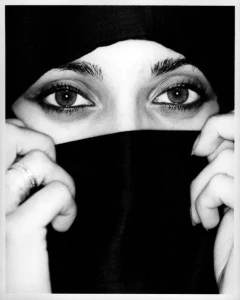The first two words that crossed my mind when I started writing a blog on Muslim fashion were Oppression and Expression. As I tried to build the blog around these two pillars, I realized that the two words are truly the essence of a woman, in particular a Muslim woman.
When we think of Muslim women in today’s post-Bin Laden world, what is the first word that comes to our mind? I would think that the unanimous answer will be Oppression. What is the first image that seeps into our mind? Most likely of a woman wrapped in yards and mounds of cloth, eyes peeking from between the wrapped clothing, head bowed. Whether you call it a burqa, hijab or an ayab, it is binding, restricting and suffocating.
Of course, I absolutely realize and am aware of the fact, that there are many liberated, emancipated Muslim women who do not wear the head/body covering and some who even choose to wear it of their own free will without any Oppression whatsoever. However, the majority’s perception of a Muslim woman is that of being oppressed and bound, literally and metaphorically.
Oppression is not restricted only to Muslim women. Women from times immemorial have struggled to express themselves and attain their individuality. Women have faced struggles in all walks of life-the first woman on the Supreme Court Bench, the first woman to be the CEO of a fortune 500 company, the first woman who was allowed into the Gentleman’s Club, the first woman who has yet not become the President of the United States. Recent studies have clearly shown that the fairer sex is the lower wage earner for similar positions held by both the genders.
It has been a long, winding struggle and continues to be a struggle for women, hence the expression “the glass ceiling.” Have we women truly broken the glass ceiling or only made a fissure in it?
Yet, as women we all have the innate desire to express ourselves, our individuality and our essence. A Western woman may exercise that expression by wearing a bold Herve Leger bandage dress (an irony indeed that an emancipated woman needs to wear a bandaged dress to be bound and the bound woman wants to be free.)
The more demure Muslim woman, who is bound by centuries of traditions, customs and culture, will probably express herself by lining her beautiful eyes with dark, dark kohl and place intricate henna designs on her hands and feet. After all, for some such women, only the eyes and the tips of the extremities are the exposed body parts.
For the more unfettered Muslim woman, for example from the United Arab Emirates, the Expression is seen in a peek of the expensive Jimmy Choo or Roger Vivier heels or a quick flash of the Cartier tiger bracelet on the delicate wrist or the limited edition, diamond encrusted Fendi glasses forming a part of the shield along with the hijab.
Someday, the “veil” will be pierced forever; not only for Muslim women, but women in general. No more glass ceilings to break, no Oppression, only Expression.


